The Fitall Plug
Fits everything?
R.W.Rumble
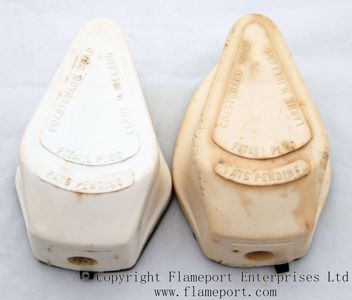
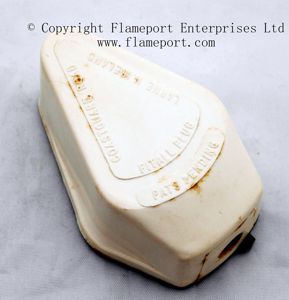 This item is a Fitall Plug, made by R.W. Rumble (G.B.) Ltd of Larne, Northern Ireland.
This item is a Fitall Plug, made by R.W. Rumble (G.B.) Ltd of Larne, Northern Ireland.
It is described as a 5 in 1 Fused Plug, and after selecting the relevant pins, will fit into 5A, 15A and 13A 3 pin outlets, and 5A and 15A 2 pin outlets.
Original Box

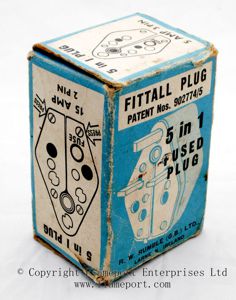 The box shows the five possible variations of pins, and confusingly describes it as a 'Fittall' plug rather than 'Fitall' as on the plug itself.
The box shows the five possible variations of pins, and confusingly describes it as a 'Fittall' plug rather than 'Fitall' as on the plug itself.
Note for the 2 pin versions, the actual pins are the same, but it is necessary to squash the plug sides together to reduce the spacing between the pins. Ingenious - or a total disaster waiting to happen?
Pin Holes
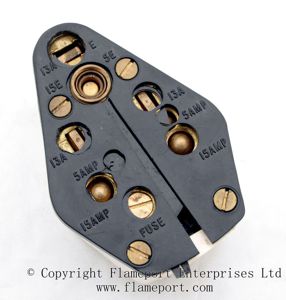
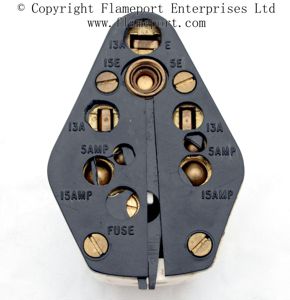 The back is marked with the various ratings. Four screws secure the cover.
The back is marked with the various ratings. Four screws secure the cover.
The fuse is located under a brass screw near the bottom left.
The pins are selected using the small black plastic lever to uncover the relevant holes. The pins will then drop out and can be rotated to lock them into place.
Two different models
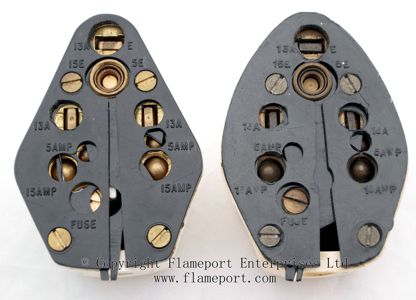 Substantially similar, however the plug on the right has a more rounded shape and the markings in the plastic are much lower quality.
Substantially similar, however the plug on the right has a more rounded shape and the markings in the plastic are much lower quality.
15 Amp, Round Pins
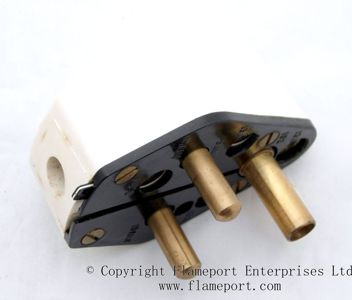 This uses the three larger sized round pins, and fits socket outlets to BS546.
This uses the three larger sized round pins, and fits socket outlets to BS546.
If only 2 pins are required for a 2 pin socket, the top earth pin is not used. As the pin spacing is narrower on 2 pin sockets, the plug body can be squashed to move the pins closer together.
5 Amp, Round Pins
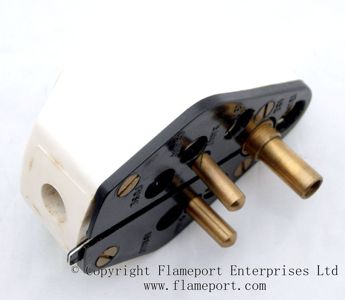 5A also uses 3 round pins, but smaller in diameter. The L and N pins are separate. The earth pin is contained inside the hollow round 15A pin.
5A also uses 3 round pins, but smaller in diameter. The L and N pins are separate. The earth pin is contained inside the hollow round 15A pin.
As with the 15A, if two pins are required, the plug must be pressed at the sides to move the pins closir together.
13 Amp, Square Pins
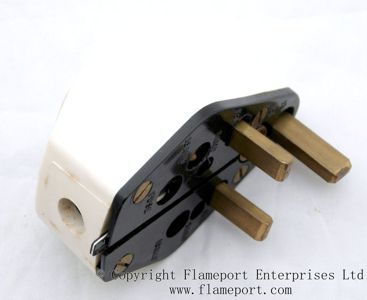 These pins are totally separate from the others, and rotate 90 degrees to lock in position.
These pins are totally separate from the others, and rotate 90 degrees to lock in position.
They fit into BS1363 socket outlets, the same type used today.
As with other plugs from the same era, the pins are unsleeved.
Cover Removed
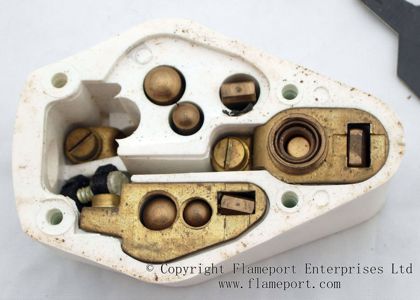 The cover is secured with four brass screws, which bite directly into the plastic of the cover. This ensures the minimum lifetime for the device, as the holes will wear away each time the cover is removed and replaced.
The cover is secured with four brass screws, which bite directly into the plastic of the cover. This ensures the minimum lifetime for the device, as the holes will wear away each time the cover is removed and replaced.
Connections are made to three brass terminals. There is a flex grip, which is the black plastic item loose near the cable entry hole.
Inside Components
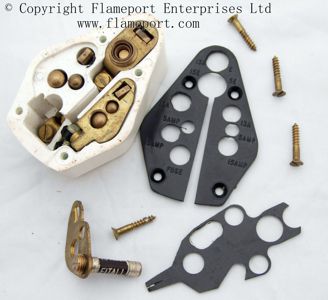 The black plastic cover has a slot to enable the whole plug to be deformed when used with 2 pin sockets.
The black plastic cover has a slot to enable the whole plug to be deformed when used with 2 pin sockets.
The black plastic plate underneath is designed to allow only one set of pins to be selected at a time.
A fuse is provided, and fits into a brass plate. This plate contains threaded holes for each of the different sized pins.
The round pins have threaded ends, and therefore can be screwed into the brass plates when the pins are extended. The square pins have a spring end, and once pulled through the plate are rotated by 90 degrees, the spring then holding them against the plate.
Instructions
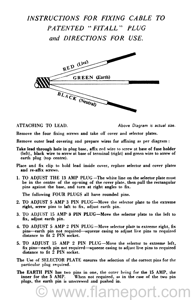
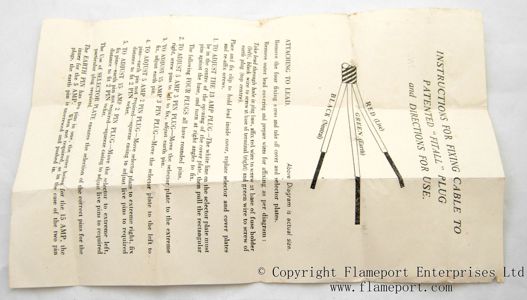 The original instruction leaflet, and a reimaged version of the same.
The original instruction leaflet, and a reimaged version of the same.
Possible Failure
One possible failure is that if one of the live pins for a different socket was left exposed, it could come into contact with the face of the socket it was plugged into.
This is not a problem when a plastic socket is used.
If a metal socket was used, that live pin has just shorted against the metal socket!
The plastic selector plate is designed to prevent this from happening - however the distance between the plate holding the pins in or not is very small indeed.
Another issue is that a high powered appliance such as an electric fire could be wired to this, and then plugged into a 5A outlet. Hopefully a fuse in the fusebox would blow to prevent fire.
Video
Video showing the various pin combinations, internal components and the box.


